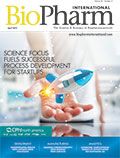What’s New in Downstream Processing
The latest advances in downstream processing include remote monitoring, membrane chromatography technology, single-use sensors, and new uses of data analytics.
VRD/Stock.Adobe.com

Technological advancements for downstream operations are crucial for maintaining efficiency and driving innovation in biomanufacturing. The following products and developments hold promise for improving the risks in this area of bioprocessing.
Updated clinical water purification system
The Milli-Q CLX 7000 clinical water purification system from MilliporeSigma has been updated with a new cloud-based, remote lab water service and monitoring capability (1).The Milli-Q Connect online service portal provides digital access to water and system data, allowing users to monitor lab performance remotely and securely.
The Milli-Q Connect system turns passive data into active, actionable information that is available remotely. This process streamlines the production of quality reports, which can be produced in minutes, according to the company.
Other benefits include:
- Remote access to view real-time system information and water quality data from anywhere at any time
- Immediate and customized notifications, with remote access and control of the water system available from a secure online portal
- Remote diagnostics, and potentially repair, available directly through web-based portal
- Automatic data backup and rapid retrieval via Milli-Q Connect platform simplifies audit preparation and lab accreditation.
“Scientists have come to expect the same instant connectivity in their lab as they experience in their personal lives,” said Jean-Charles Wirth, head of Applied Solutions at MilliporeSigma, in a March 18, 2019 company press release. “This Internet-of-Things technology gives our customers accessibility to view real-time system information, customized notifications, and rapid online diagnostics, whether they are at the lab or at home.”
Membrane chromatography systems in development
Biopharmaceutical supplier Sartorius Stedim Biotech (SSB) and Novasep, a provider of molecule production and purification services, have entered into a collaboration in which the companies will develop membrane chromatography systems using Novasep’s BioSC platform and SSB’s single-use technology (2).
According to SSB, systems that are currently on the market are designed for resins, but do not take full advantage of membrane chromatography capabilities. Optimally run membrane chromatography processes will provide an efficient alternative to batch and continuous resin-based chromatography, resulting in higher productivity, smaller-scale operations, and increased robustness, as stated by SBB in a March 5, 2019 press release.
Novasep specializes in the design, manufacture and control of resin-based batch and continuous chromatography systems. The company’s BioSc platform is a low-pressure continuous chromatography solution for the purification of monoclonal antibodies, blood fractions, and other biologics. The platform is adaptable, with operations from one column up to six columns in batch, parallel batch, continuous chromatography, or continuous process. Novasep states that the platform can easily switch from batch to continuous, has a reduction of resin and buffer by up to 75%, and increased productivity by two- to six-fold.
Partnership to enhance single-use sensors
Pall Corporation, a filtration, separation, and purification solutions provider, has partnered with sensor technology provider Broadley-James Corporation to integrate and distribute Broadley-James’ advanced single-use probe and flow cell pH sensors (3). The sensors have both upstream and downstream operation applications and will be integrated into Pall Biotech’s single-use technologies, as well as other commercially available bioprocessing platforms.
The single-use pH sensors leverage glass electrochemical technology, which according to Pall, is the only method that meets international standards for pH measurement. The design includes a calibrated buffer storage environment for the sensor to eliminate previous constraints during pre-integration of glass pH sensors into consumables. Users will be able to operate in closed systems without sacrificing performance.
The Broadley-James single-use probe and flow cell pH sensors are currently in beta testing and will be available exclusively through Pall Biotech once launched. Parallel technical and process development support is also available to aid product use.
“Customers currently rely on calibration data gathered before the sensor is sterilized, which can affect the measurement accuracy,” said Robert Garrahy, vice-president at Broadley-James, in a March 11, 2019 press release. “Our patent-pending new storage solution design features a known pH buffer, enabling robust pre-use calibration. By pairing trusted technology with cutting-edge design, we are able to offer the best balance of risk reduction and performance.”
Digital data exchange program may offer reduced raw material variability
GE Healthcare and Amgen have established a digital data exchange collaboration program that will include advanced data analytics to increase the understanding of the relationship between raw material variability and process performance during the manufacture of biologic medicines (4). The companies will be installing a seamless connection for data transfer between GE Healthcare raw material manufacturing sites and Amgen’s process development center in Cambridge, MA.
“This project is a perfect example of the type of collaboration we want to drive together with the biopharma industry, pushing the boundaries of manufacturing efficiency and performance reliability even further,” said Olivier Loeillot, general manager, BioProcess at GE Healthcare Life Sciences, in a March 11, 2019 press release. “The data exchange capabilities that we are introducing can have a huge positive impact on the biomanufacturing operations, and this is only the beginning of our digital journey.”
According to GE, the ability to detect and monitor raw material variability through data integration will be an important step to ensuring consistent and predictable biomanufacturing performance. Data insights can be used to drive process and product improvements and reduce the potential for supply disruptions.
“We know that slight changes in raw materials can have a significant impact on product attributes of biotechnology medicines,” said Rohini Deshpande, vice-president, Attribute Sciences at Amgen, in the press release. “At Amgen, we seek to understand our end-to-end supply chain, from raw materials to finished products. By analyzing data directly from the manufacturing site for raw materials, we can have a better understanding of the effect of variations in raw materials on our products.”
References
1. MilliporeSigma, “MilliporeSigma’s Milli-Q Connect Combines Deep Water Purification Expertise with Cloud-based Digital Technology,” Press Release, March 18, 2019.
2. Sartorius Stedim Biotech, “Sartorius Stedim Biotech and Novasep to Develop Novel Systems for Membrane Chromatography,” Press Release, March 5, 2019.
3. Pall Corporation, “Pall Corporation and Broadley-James Cooperate to Deliver Next Generation Single-Use Sensor Technologies to the Life Science Market,” Press Release, March 11, 2019.
4. GE Healthcare, “GE Healthcare Announces Digital Collaboration with Amgen to Improve Biomanufacturing Performance Reliability,” Press Release, March 11, 2019.
Article Details
BioPharm International
Volume 32, No. 4
April 2019
Pages: 24–25
Citation
When referreing to this article, please cite it as A. Lowry, "What’s New in Downstream Processing," BioPharm International 32 (4) 2019.
